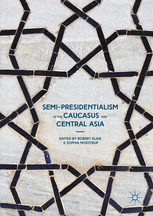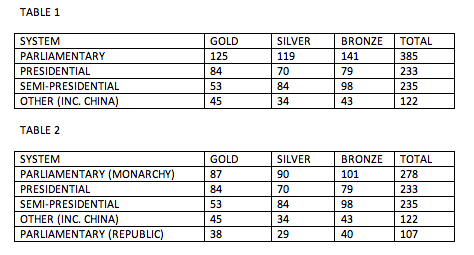This post was first published at Presidential Power

Sophia Moestrup and I have just published another edited volume on semi-presidentialism. This time the focus is on Semi-presidentialism in the Caucasus and Central Asia. There are contributions from Alex Baturo on vertical power in the post-Soviet space, Alexander Markarov on Armenia, Jody LaPorte on Azerbaijan, Malkhaz Nakashidze on Georgia, Dmitry Nurumov and Vasil Vashchanka on Kazakhstan, and Matto Fumagalli on Kyrgyzstan. Sophia and I contribute two chapters. The first addresses some misconceptions about the notion of semi-presidentlaism, such as the idea that semi-presidential regimes must have quite powerful presidents but never very powerful or very weak presidents, and also that autocracies cannot be semi-presidential – they can, not least because semi-presidential regimes do not have to comprise only countries with quite powerful presidents. Our second chapter sums up the contributions to to the volume and argues that weaker presidents make for better semi-presidentialism. This is a brief summary of this second chapter.
The main attraction of institutional analysis is that it has the potential to generate better political outcomes. Given the assumption that institutions matter, we may be able to craft them so as to mitigate or even eradicate some of the negative outcomes that would otherwise be caused by the behaviour of political actors. We wish to draw one institutional policy recommendation from this book. All else equal, countries with weaker presidents are likely to experience better outcomes than countries with stronger presidents.
There is evidence from Armenia, Georgia, and Kyrgyzstan that weaker presidents have been associated with better outcomes. In Kyrgyzstan the decline in the president’s constitutional powers has been dramatic. That said, the shift to a weak president is relatively new, dating back to 2010. Kyrgyzstan also has a history of democratic reversals. So, we should avoid any definitive judgement at this early stage. More than that, the shift occurred in the context of the collapse of the previous regime and the desire on the part of the constitution builders to trammel the power of the presidency, which was seen as one of the main obstacles to democratic consolidation under the previous regime. This suggests that any positive effects of the weak presidency may be endogenous to the choice of the new institutional framework. All the same, we note that the early period of the new constitutional framework has been marked by less presidential posturing, less executive/legislative conflict, and, for now at least, less democratic backsliding. These are positive signs.
In Armenia, the decline in presidential power has been less dramatic. The president’s constitutional powers were never as great as the other countries in the region. Moreover, even after the passage of the 2005 reforms, the president still enjoyed some not inconsiderable constitutional powers. What is more, as in Kyrgyzstan, the context in which the president’s powers were reduced in 2005 means that we have to take account of the problem of endogenous institutional choice. Further still, Armenia remains a hybrid democratic regime in which there is plenty of political competition, but where democratic procedures have been manipulated to the advantage of incumbent power holders, although perhaps less so in the most recent elections than previously. In this context, we have to be careful about any lessons that we might we wish to draw from the Armenian case. Even so, we might benefit from thinking counterfactually. What would be the situation if there were now a super-president in Armenia? Would the situation be worse? We cannot know. Yet, we do know that in practice there was a form of super-presidentialism after the passage of the 1995 constitution. We can also confidently claim that this period marked the low point of democratic performance in Armenia to date. Armenia has not experienced a weak presidency, but it has experienced very strong presidents. It is not unreasonable to conclude by comparing the experience of the 1995-2005 super-presidency and the post-2005 period that the latter was less problematic.
By far the strongest evidence, though, comes from Georgia. Here, there were two periods when the problem of endogenous institutional choice was at least partly offset because of a dramatic change in the political context. In the first period there was a very strong president. In the second period, there was a very weak president. In this latter case, it is tempting to think in terms of quasi-experimental conditions. In the same historical, cultural, economic, and social context, there was an institutional treatment, namely the move to a weak presidency. The result has been much better political performance. The period of cohabitation under the previous president-parliamentary form of semi-presidentialism was marked by intense president/prime ministerial conflict as well as conflict between the president and the government and legislature generally. By contrast, the recent period under the weak presidency and a premier-presidential form of government has, to date, been characterized by much calmer relations. Indeed, this latter period is doubly interesting because the president distanced himself from his former political allies immediately after his election. The resulting situation should not be classed as a period of cohabitation, but it is certainly not a period where the president’s loyalty to the ruling party has quashed, perhaps artificially, any political competition within the executive branch. While there have been major disagreements between the president and the government, they have not become regime threatening. Indeed, arguably, post-2013 president/government relations in Georgia resemble those in countries like the Czech Republic or Slovakia where weak but directly elected presidents act as a counterweight to the government, but where there are no serious attempts to assume real presidential power.
If we are right to conclude that weaker presidents are better presidents, then we also wish to assert that the party system is an important intervening variable, as indicated above. It is perhaps no coincidence that in Georgia there has been a solid parliamentary majority since 2013. In other words, the president has not had the opportunity to try to offset his weak constitutional powers by building an alternative and potentially destabilizing pro-presidential coalition within the legislature. We might add that there has also been a relatively stable legislative majority in Kyrgyzstan since the 2010 reforms. Again, the president has not had the incentive to craft a majority that is personally loyal to him and that often requires the distribution of state resources in a geographically skewed and perhaps even corrupt way. In Armenia, by contrast, presidents have not always enjoyed a parliamentary majority and have been forced to forge coalitions in the legislature. This perhaps helps to account for the continued presence of a patronage president in a way that harms the rational functioning of the regime and democratic performance. Indeed, the recent constitutional reform that will introduce a parliamentary system after the next electoral contests might confirm this suspicion. The introduction of a parliamentary system and a weak president should be a positive development on the basis of our logic, but it may merely be a way of maintaining patronage politics in the context of an uninstitutionalized party system.
So, we acknowledge that many economic, social, and political factors affect political performance. We also believe that the party system is a particularly important variable for determining the practice of presidential politics. Even so, we claim that political performance is likely to be better when presidents have fewer powers. This suggests that constitution makers should consider the benefits of reforms that reduce the power of their presidency. We are aware that our conclusion assumes that institutions matter and, therefore, is susceptible to the problem of endogenous institutional choice, but we would like to address the endogeneity problem by arguing that even endogenously chosen weak presidents are better than endogenously chosen strong presidents. In other words, we believe that there are benefits to be gained from the endogenous selection of weak presidents. We should endeavour to create the conditions for decision makers to calculate that their system would benefit from a weak presidency. Fundamentally, if we are right that weak presidents bring benefits, we are unconcerned whether this outcome comes about endogenously or exogenously. That said, even if institutions are chosen endogenously, political actors still have to interpret the institutions with which they are faced. At some point, the economic, social, or political context is likely to change. At that point, if not before, institutions may have at least a partly exogenous impact. In those circumstances, it is better to have a weak presidency in place than a strong one. In other words, we would encourage upstream efforts to create the conditions for a constitutionally weak president. We believe that there are benefits to be gained from a system in which actors are willing to work without the presence of a super-president and that these benefits are likely to be both endogenous to institutional choice and at some point exogenous too.
We wish to make one final point. We promote the idea of a weak presidency, but we also wish to promote a weak presidency in the context of a wider constitutional and political system in which there is a genuine separation of powers and checks and balances. For example, we are not convinced that there are benefits to be gained from replacing a system in which there is a super-president and a weak prime minister by one where there is a weak president and a super-prime minister. This merely shifts the problem. It does not replace it. And it may characterise what is about to happen in Armenia. Let us express this point differently. We are not opposed to weak but directly elected presidents. As we argue in our introduction to the volume, semi-presidential constitutions are consistent with both very strong and very weak presidents. We prefer the latter. Let us make the same point in another way. We do not believe that parliamentarism with a weak but indirectly elected president is necessarily a guarantee of better political performance if there are no checks on the prime minister in the parliamentary system.
To sum up, we are happy to recommend a directly elected president as long as the president’s powers are weak and are exercised in the context of a system in which power is not concentrated in any political actor.


